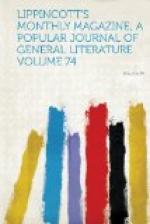and during their stay introduced much of the tropical
vegetation which we still admire. They were finally
driven away by the insurgent natives in A.D. 975,
but they left the impress of their occupation in many
Arabic words which still mark the local patois;
and as a number of the fugitives were captured and
reduced to slavery, intermarrying in the course of
time with the native population, the Moorish type
is still very noticeable amongst the peasantry.
Freed from the Saracenic yoke, the Nicois lived in
peace for nearly two centuries, being only disturbed
from time to time by the unwelcome visitations of
pirates. Later on, toward the middle of the thirteenth
century, like most other Southern and Italian cities,
Nice fell a victim to the constant quarrels of the
powerful families allied respectively to the Ghibelline
and Guelphic factions. Thus, the incessant broils
between the Lascaris of Tenda, the Grimaldis of Monaco
and the Dorias of Dolceacqua desolated the surrounding
country, and often reduced the city to a state of
siege. The Nicois were compelled to keep up a
perpetual guerilla, which, however inspiriting, was
by no means conducive to their material prosperity.
In 1364 an invasion of locusts from Africa led to a
famine, and ultimately a plague which destroyed two-thirds
of the population. The people, attributing their
misfortunes to the intercession of the Jews with the
powers below, rose up and massacred them: only
five Israelites out of over two thousand are said to
have escaped their blind fury. When order was
at last re-established, and the Nicois began to settle
down again, they perceived their impoverished and
subordinate position to be so alarming that their only
chance of safety was immediately to place themselves
under the protection of the dukes of Savoy, who for
a century and a half defended them from the attacks
of their numerous enemies in a most valiant manner.
But in 1521, Francis I. of France wrenched the city
and province from the beneficent rule of the Savoyards
and proclaimed himself count of Nice. In 1524
war broke out between Francis and the emperor Charles
V., and the contending armies alternately devastated
and pillaged Nice and its environs. The pest
reappeared, and with it a drought and famine of so
fearful a character that many thousand persons perished,
and others in their despair slew themselves.
Pope Paul III. undertook the difficult task of reconciling
the belligerents, and even went so far as to travel
to Nice for the purpose. A marble cross which
gives its name to a suburb of the town ("La Croix
de Marbre”) still marks the spot where the conference
took place in which Francis and Charles swore a peace
in the presence of His Holiness which they took the
first opportunity to violate. In 1540 the war
recommenced, and a number of dissolute young men of
good family formed themselves into organized companies
of bandits and overran the country, to the terror
of the wretched peasantry and the utter ruin of many




